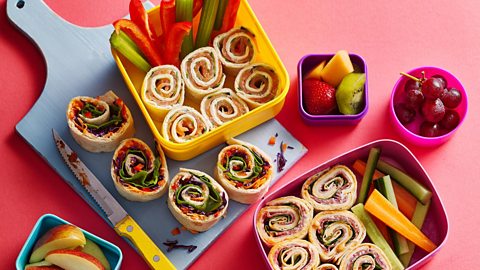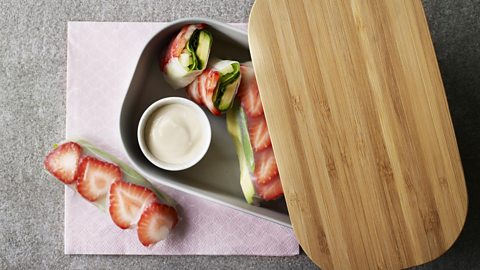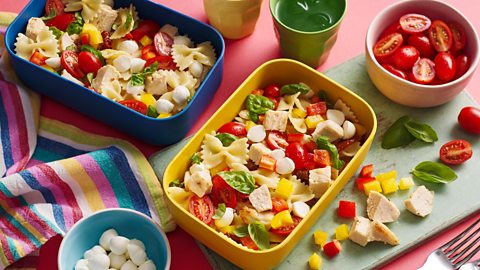How to make healthy packed lunches on a budget
Make packed lunches exciting and nutritious without having to spend loads of time (and cash) on them.

Whether you’re trying to save money on shop-bought food at work or want to fill up your child’s lunch box with nutritious goodies for school, here’s how you can prep a packed lunch to look forward to, with minimal fuss and cost.
How to help make packed lunches more affordable
Dr Charlotte Evans – an associate professor at the University of Leeds, specialising in nutritional epidemiology and public health – has carried out extensive research into children’s packed lunches. Her 2020 study found that fewer than two in 100 packed lunches eaten by children in English primary schools meet nutritional standards.
With the cost of living crisis driving more people into financial difficulty, Dr Evans is concerned the nutritional value of many packed lunches will decline even further as households are forced to cut back on their grocery spend.
“We’re particularly worried about widening inequalities. With the cost of food increasing, those who are just missing out on free school meals are going to struggle the most, maybe with an over-reliance on packaged food.”
So, what can we do to keep costs down for packed lunches without compromising on nutrition?
Annabel Karmel MBE is famous for creating family-friendly recipes. One of her money saving tips is to buy and cook extra portions of dinner each evening, choosing dishes that keep well overnight. This means that ingredients can be bought in larger volumes, which often means better value.
“Last night’s dinner can make the perfect school lunchbox for your little one the next day. Think chicken drumsticks, frittata or tuna pasta salad,” she says.
You could, Annabel suggests, add a few cheap extras to those lunch boxes for some extra nutrition, too. “Toasted seeds are not only delicious, nutritious and cheap but they’re so easy to make! Simply toast pumpkin and sunflower seeds in a non-stick frying pan until lightly browned and then add a little honey and soy sauce. They make a fantastic lunchbox snack and will keep for a week.”
If you think batch cooking is just for dinners, though, think again. “I have simple recipes like cheese and cherry tomato muffins and apple and carrot muffins which are perfect for cooking in batches and freezing. Simply remove from the freezer in the morning and they will have defrosted by lunchtime.
“In cold weather you can make delicious soups from things like leftover vegetables, chicken and pasta. I recommend investing in a small flask to freeze so that you can take out individual portions later.”
Speaking of your freezer, make sure it’s pulling its weight when it comes to cutting down on food waste, as this could help save on groceries. “Get into the habit of freezing leftover pittas, tortilla wraps, bagels and similar – that way you’re not throwing away stale bread.”
Restaurateur James Ramsden is such a fan of packed lunches that he’s written a book on them, called Love Your Lunchbox. He’s also big on saving leftovers to bolster meals for the next day. “Keep your bread crusts to make lovely croutons for salads or to add bulk and depth to thrifty soups,” he suggests.
“Go big on tins and spices, too – they’re thrifty ways of bringing flavour and calories to lunchtime.” And when it comes to costly meat or fish, think about using it as an “accent” as opposed to the star of the dish, he says. For instance, chopped anchovies or a small amount of chorizo would work well in a salad with veggies and tinned pulses, adding nutritional value and flavour without heavily increasing the cost per portion.
Alternatively, Dr Shireen Kassam – who lectures at Winchester University and King’s College London and is a champion of plant-based nutrition – suggests using cheap, plant-based proteins in place of meat. “Canned chickpeas dressed with lemon, marinated tofu and hummus all help to make meals more filling.”
Healthy packed lunches for fussy eaters

Dr Evans explains that fruit and veg (especially the latter) is where both adults and children often fall short in terms of nutrition. When you’re feeding picky eaters, this can become an even bigger issue.
“Hitting nutritional targets can feel like a real challenge with a fussy eater – I should know, I had three! My advice would be to test out the foods you want to put in your child’s lunchbox at home first, to avoid it being returned to sender.”
Sometimes, presentation can make all the difference too, she points out.
“Cutting sandwiches into shapes using cookie cutters adds oodles of child appeal. There are so many healthy and protein-packed sandwich fillings to pick from, like shredded chicken with chopped tomato, chopped hard-boiled egg, sliced turkey and cheese. Also consider mixing up sandwiches by making wraps. Tomato, mozzarella and pesto is always a winner, or keep things simple and kiddie-friendly with chicken, sweetcorn, cucumber, lettuce and mayonnaise.”
You could also opt for a variety of bitesize snacks to appease picky eaters, suggests Annabelle: “Things like mini chicken balls, pinwheel sandwiches, and mini muffins take the fuss out of lunchtimes and tend to be a real hit with children.”
Fun miniature snacks might not do the trick for fussy eaters if they’re grown up, though. If you’re an adult who’s less than enthusiastic about fruit and veg, Dr Kassam suggests pairing it with a healthy dip such as guacamole, hummus or a homemade cocoa nut butter dip.
“Also, try adding veg to baked goods, for example carrot and banana muffins or sweet potato brownies,” she says. This is a great way to pack in more vegetables – just look for recipes which don’t include refined sugars.
A well-balanced lunch isn’t just about working towards that five-a-day, though – it takes a wide variety of ingredients to meet all of our nutritional needs. To help plan for this, Dr Evans says that instead of assessing the nutrients in each different lunch (which could easily become overwhelming and expensive), look at your intake over the whole week. That makes things much more manageable and helps avoid getting stuck in a rut, eating the same meal every day.
How to make packed lunches easy

As well as affordable and nutritious, packed lunches should be simple and speedy to prep – most of us are already short on time throughout the week, after all. Here are some tactics for making healthy, budget-friendly packed lunches quick and easy.
Don’t over complicate meals: When you start making packed lunches, the novelty might lead you to spend hours in the kitchen preparing dishes with lots of different elements. However, once the initial enthusiasm fades, making lunches could become a chore. So keep dishes simple, limited to a few ingredients, and avoid foods which require long cook times or a lot of prep. Tinned foods and salad ingredients are your friends.
Be prepared: Mornings are rushed in most households, so finding time to make packed lunches can be tricky. But it can also be tough to squeeze it into the evenings – after cooking dinner, the last thing most of us will fancy doing is more food prep. That’s why James is a fan of turning leftovers from evening meals into snack-style lunches. “A few bits of long-stem broccoli for dunking in hot sauce here, a little cold chicken salad there… Ultimately it’s your lunch and there’s no right or wrong way to go about it.” So, think outside the box and consider cooking extra portions and sides for dinner if you can – this won’t add to your workload but will mean you have a variety of foods to fill up lunchboxes with the next day.
Think ahead: To save time and avoid disappointing lunches, think about how your food will fare between when you make it and when you eat it. You don’t want to open your lunchbox to find what’s inside has lost it’s shape, texture or flavour. Being smart in this way means you can prep lunch for several days in one batch, saving time and energy. For instance, if you’re making a salad, pack your dressing in a separate pot, says Annabelle. And when it comes to classic sarnies, be savvy with your fillings: “If you have quite a wet filling like chicken and sweetcorn with mayonnaise, then I would put lettuce leaves between the filling and the bread, so the bread doesn’t turn soggy.”
If you are concerned about facing hardship, including food poverty, help and support is available.
Originally published August 2022.